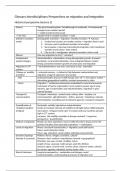Glossary Interdisciplinary Perspectives on migration and integration
Historical perspective (lecture 2)
Polanyi ‘The great transformation’: breakthrough to modernity fundamental
changes in pre-modern period
>< stable and harmonious past
>< De Vries ‘people lived in unstable societies’ = myth
Zelinski’s transition Demographic transition + migration: mobility transition 4 phases:
model 1. Limited and circular: pre-modern society > migration (inter-rural)
2. Increase: early transitional societies (rural-urban)
3. Rural exodus + decrease international emigration: late transitional
societies (rural urban + inter-urban)
4. City-to-city + immigration: advanced societies (urban-rural)
Dickens One-way migration to city (= ‘monster’)
Fundamental Industrialisation, urbanisation, strong demographic growth, transport
societal changes revolution, rural proletarianization, more integrated labour market;
Strong connection between growth of urban poor and migration
Migration in 19th = new phenomenon, one-way: rural areas to city, ‘miserable’
century
Critique on ‘mobility ≠ universal process, = a-historical, link between modernisation and
transition’ migration, image of sedentary rural society
- Tilly proletarianization process in NW-Europe since 16 th C: free labour market >
stimulating geographical mobility; constant movement to cities
- Moch Migration = ‘continuous phenomena embedded in social and economic
framework of human organization’ (early modern period, age of early
industry, age of urbanisation and industrialisation, migration in post-
colonial Europe)
Transport & Transport: waterways > paved roads, railway, bike > airplane, car
communication Communication: alphabetisation > letters, journals > telephone, internet
Intermediairies: travelling and recruitment agencies, transport companies,
…
Quantification of Hochstadt: mobility high before industrialisation
‘mobility transition’ Pooley & Turnbull: intensity of mobility in UK hight before 1800 (industry)
(critique) Van Lottum: ‘emigrant stock rates’ in London and Low Countries already
high in 17th century
Lucassen: ‘the mobility transition in Europe revisited’ > long-term
perspective + quantification
Motives of migration People can have aspirations, but in reality they don’t always end in the
position/situation they expected (aspirations >< realisations)
Levels of migration Macro: structural characteristics > migration, push-pull factors
Meso: social networks, family
Micro: age, education, social capital, individual characteristics
Duration (typology Motives: forces, refugee, economic, cultural
Hoerder & Lucassen) Distance: short, medium, long distance (mental ≠ geographical)
Direction: one-way, circular, multiple, return
Length of stay: seasonal, multi-annual, work-life, lifetime
Socioeco space: rural-to-rural, rural-to-urban, urban-to-urban, colonial
Eco sector: agrarian, industrial, service-sector, elite
Role of historians Long-term perspective > continuities and changes, avoid
misinterpretation, understanding processes of migration and
, acculturalisation > time and place differences, linking migration to broader
processes of developments
Macro-level Economic cycles & shifting economic centres in Europe > hierarchical
urbanisation urban networks (Italy, Spain, Antwerp, Amsterdam, London, Hamburg)
Demographic factor: regulator of city populations > dependence on rural
migration (urban graveyard effect, fast growing cities); European Marriage
Pattern & individual life cycles; proletarianization processes (people as
mobile labourers)
- Underestimation > high turnover of population: seasonal patters of labour migration, rising
mobility in many directions (not only from rural hinterland to cities)
- Occupational < economic profiles of city of destination (requirements)
profiles < characteristics of region of origin (push factors, regional patterns of
labour specialisation) the stronger push factors, the less migration was
adapted to local opportunity structures (Clark: subsistence >< betterment)
Meso- and micro- Social and cultural process: individual and family characteristics + social
level urbanisation networks and access to information and communication channels
Information and networks: social bias, spatial patterns < transport &
communication networks, proximity < individual & organisational
networks
Pre-industrial Long distance >< hinterland (job specialisation, W/M ratio, life cycle,
information, mobility levels, duration, local interaction)
Industrial (19th C) Shift in social position and distance travel > democratisation of long-
distance migration: increase transport facilities, decrease transport costs;
new communication channels; internationalism > proletarianization
Social differentiation remains: unequal access (to information & networks)
Gender Men = pioneers + autonomous, women = followers + dependent on family
decisions; more attention for autonomy, networks and behaviour of
women in recent research
- Trends Rising migration: male-dominant (1870-WOII)
Declining migration: female-dominant (during and between wars)
gender balanced
- Gabaccia Variations between groups (more NW-Europe)
- Differences More gender-balanced in USA + N-Eu >< more male-dominant in S-Eu +
China + Japan
Explanations: financial means, racism, recruiting systems and labour
possibilities for women, economic possibilities, specific migration patterns
for specific groups, patriarchal domination over women, migration policies
Focus on national Focus on impact of (supra)national state and (national) border
state Problematic from historical perspective: importance of internal migration,
cities (autonomy) determined the difference between ‘citizens’ and
‘foreigners’ > access to citizenship, states don’t have a grip on migration
Autonomy of cities > policy making on urban level (urban governance): multi-layered urban
institutions, > great importance of belonging to urban ‘communitas’
(citizens >< foreigners)
- 3 main concerns 1. Regulation of labour market: migration for stimulating labour market
> access to labour; attracting ‘useful’ migrants > economic needs
2. Management of local recourses (social policy): access to social
support > depending on local belonging > migrants >< citizens;
press costs in periods of eco crisis > ‘deserving’ >< ‘undeserving’
poor
3. Maintenance of political stability (public order): religion, people with




